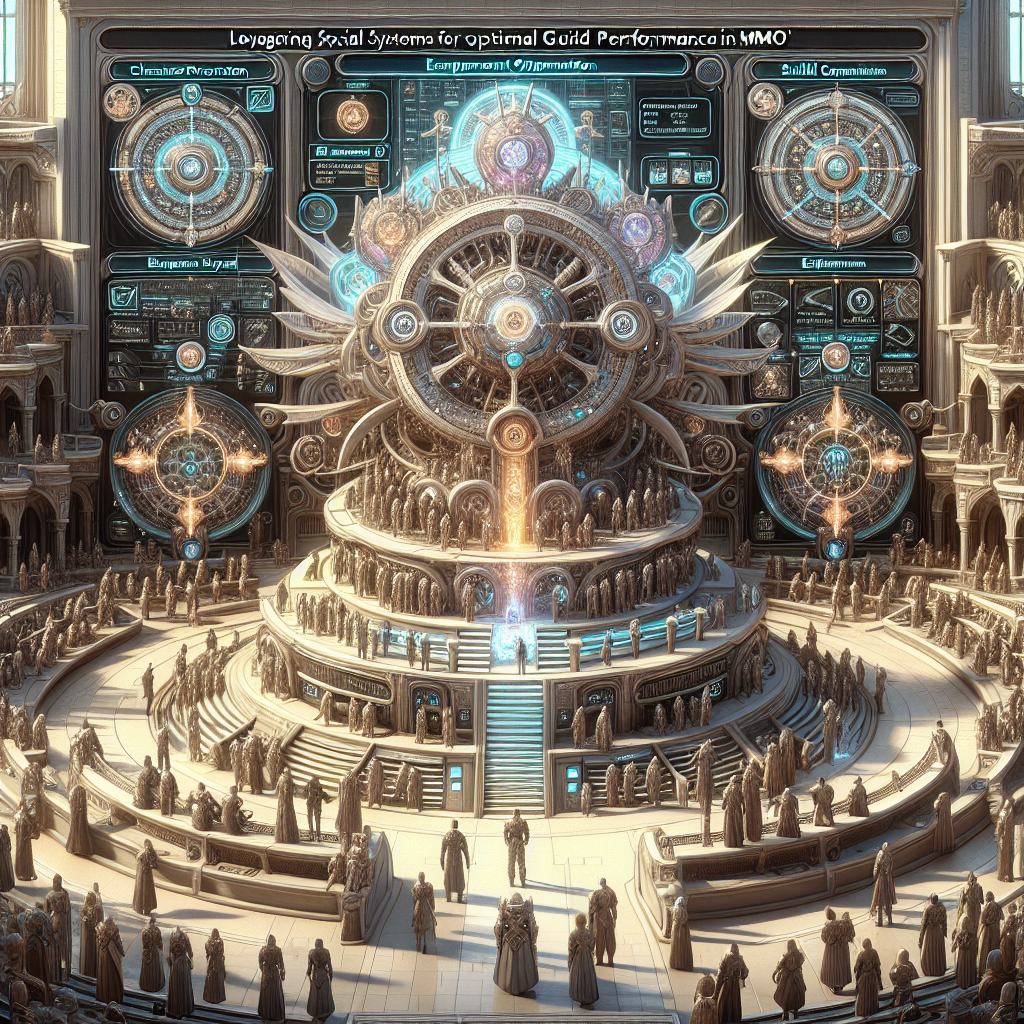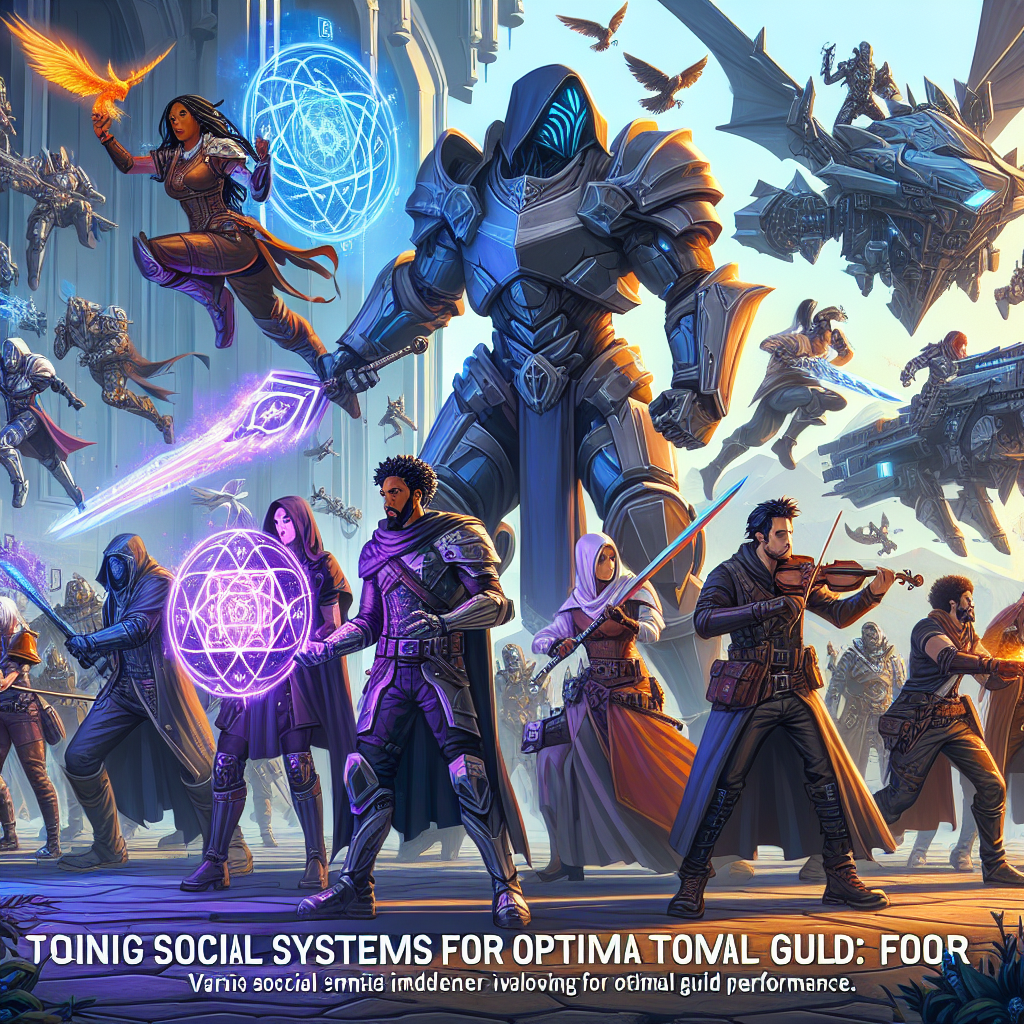Leveraging Social Systems for Optimal Guild Performance in MMOs
Discover the Power of Guild Communication, Rank Structures, and Community Events to Enhance Team Cohesion, Player Progression, and In-Game Achievement Success
In the dynamic world of Massively Multiplayer Online (MMO) games, a strong and thriving guild can make all the difference in achieving your in-game goals. Whether you're a seasoned MMO veteran or a newcomer to the genre, understanding how to leverage the social systems within your guild can unlock a wealth of benefits, from enhanced team cohesion and player progression to greater in-game success and recognition.
In this comprehensive guide, we'll explore the key strategies and best practices for harnessing the power of guild communication, rank structures, and community events to elevate your guild's performance to new heights.
Fostering Effective Guild Communication
At the heart of a successful guild lies effective communication. By establishing clear channels of communication and encouraging active dialogue among members, you can foster a sense of camaraderie, improve coordination, and ensure that everyone is on the same page.
Utilize Dedicated Communication Platforms
Invest in a dedicated communication platform that allows your guild members to stay connected, whether it's a Discord server, a guild forum, or a messaging app like Slack. These platforms provide a centralized hub for sharing information, coordinating activities, and fostering discussions.
- Discord: A popular choice for MMO guilds, Discord offers voice and text channels, file sharing, and integrated bots to streamline communication and collaboration.
- Guild Forums: Maintain a dedicated guild forum where members can post announcements, share strategies, and engage in in-depth discussions about the game and the guild's activities.
- Slack: Slack's intuitive interface and extensive integration options make it a versatile choice for guild communication, allowing seamless collaboration and task management.
Establish Clear Communication Protocols
To ensure that your guild's communication remains organized and efficient, establish clear protocols and guidelines. This might include:
- Designated Channels: Clearly define the purpose of each communication channel (e.g., general chat, raid planning, social discussions) to keep conversations focused and relevant.
- Responsiveness Expectations: Set expectations for how quickly members should respond to important messages or queries, particularly for time-sensitive activities like group events or raids.
- Feedback and Reporting: Encourage members to provide feedback and report any issues or concerns through the appropriate channels, ensuring that problems are addressed in a timely manner.
Foster Open and Transparent Communication
Encourage an open and transparent communication culture within your guild. This includes:
- Regular Updates: Provide frequent updates on the guild's activities, progress, and future plans to keep all members informed and engaged.
- Inclusive Discussions: Actively solicit input and feedback from guild members, creating an environment where everyone's voice is heard and valued.
- Conflict Resolution: Establish clear protocols for addressing conflicts or disagreements, ensuring that they are resolved in a constructive and diplomatic manner.
By prioritizing effective communication, you can strengthen the bonds within your guild, improve coordination and decision-making, and create a supportive environment that empowers all members to contribute to the guild's success.
Implementing Robust Rank Structures
A well-designed rank structure can be a powerful tool for organizing your guild, delegating responsibilities, and incentivizing member engagement. By establishing clear roles and expectations, you can foster a sense of ownership and accountability among your guild members.
Define Distinct Rank Tiers
Carefully consider the rank structure that best suits your guild's size, goals, and overall culture. Common rank tiers may include:
- Guild Leader: The primary decision-maker and overall coordinator of the guild's activities.
- Officers: Trusted members who assist the guild leader in managing the guild and leading specific initiatives.
- Raid Leaders: Experienced players who coordinate and lead group activities, such as raids and dungeons.
- Core Members: Dedicated and active players who form the backbone of the guild's activities.
- Recruits: New members who are in the process of proving their commitment and earning a higher rank.
Establish Clear Promotion Criteria
Define the specific criteria and requirements for members to earn promotions within the guild's rank structure. This may include:
- Participation and Attendance: Tracking member activity, such as attendance at scheduled events, contribution to guild projects, and overall engagement.
- Skill and Performance: Evaluating a member's in-game skills, ability to contribute to group activities, and overall performance within the guild.
- Leadership and Initiative: Recognizing members who demonstrate initiative, take on additional responsibilities, and exhibit strong leadership qualities.
- Seniority and Loyalty: Considering a member's length of service and dedication to the guild over time.
Empower Rank-Specific Responsibilities
Assign clear responsibilities and decision-making authority to each rank within your guild's structure. This helps members understand their roles and feel empowered to contribute in meaningful ways. For example:
- Guild Leader: Oversees the overall strategy, vision, and direction of the guild.
- Officers: Assist the guild leader in managing day-to-day operations, coordinating events, and addressing member concerns.
- Raid Leaders: Plan and lead group activities, such as raids and dungeons, ensuring optimal team composition and execution.
- Core Members: Participate actively in guild events, contribute to discussions, and serve as role models for newer members.
- Recruits: Focus on learning the game, developing their skills, and demonstrating their commitment to the guild.
By implementing a well-structured rank system, you can create a clear path for advancement, foster a sense of ownership and accountability among your members, and streamline the coordination of guild activities.
Organizing Engaging Community Events
In addition to effective communication and a robust rank structure, hosting engaging community events can be a powerful way to strengthen the bonds within your guild and enhance overall performance.
Plan Recurring Social Activities
Schedule regular social events that allow your guild members to connect on a personal level, beyond just the game itself. These activities can include:
- Virtual Game Nights: Organize game sessions for non-MMO games, such as trivia, board games, or party games, to foster a sense of camaraderie.
- Member Showcases: Give members the opportunity to share their interests, hobbies, or talents with the rest of the guild, promoting a well-rounded community.
- Guild Meetups: If feasible, arrange in-person meetups for members who live in close proximity, allowing them to connect face-to-face.
Coordinate In-Game Events and Challenges
Organize in-game events and challenges that encourage collaboration, friendly competition, and a sense of shared accomplishment. Examples include:
- Guild Tournaments: Host tournaments for specific game modes or activities, such as PvP battles, dungeon runs, or crafting competitions.
- Scavenger Hunts: Design scavenger hunts that task members with finding specific items, completing unique tasks, or exploring different areas of the game world.
- Skill-Building Workshops: Offer workshops or training sessions to help members improve their in-game abilities, such as class-specific rotations, combat tactics, or resource gathering techniques.
Celebrate Milestones and Achievements
Acknowledge and celebrate the guild's milestones and individual member achievements. This helps to foster a sense of pride, belonging, and motivation among your guild members. Examples include:
- Guild Anniversary Celebrations: Mark the anniversary of your guild's founding with special in-game activities, rewards, or even virtual parties.
- Member Spotlights: Regularly highlight the contributions, accomplishments, and personal stories of individual guild members to showcase their value and inspire others.
- Leaderboard Tracking: Maintain leaderboards or rankings that recognize members for their outstanding performance, such as top damage dealers, most valuable players, or most dedicated contributors.
By organizing engaging community events, you can strengthen the bonds between your guild members, foster a sense of belonging and ownership, and ultimately enhance the overall performance and cohesion of your guild.
Key Takeaways
In the dynamic world of MMOs, leveraging the power of social systems within your guild can be a game-changer for achieving optimal in-game performance and success. By focusing on effective communication, robust rank structures, and engaging community events, you can:
- Enhance team cohesion and collaboration through clear communication protocols and transparent decision-making.
- Empower members and foster a sense of ownership by implementing a well-designed rank structure with defined responsibilities and promotion criteria.
- Strengthen the social fabric of your guild and boost member engagement through the organization of recurring community events and the celebration of milestones and achievements.
Remember, a thriving guild is not just about in-game progress and objectives; it's about cultivating a supportive, engaged, and enthusiastic community of players who share a common passion and work together towards shared goals. By applying the strategies outlined in this guide, you can unlock the true power of your guild and take your MMO experience to new heights.





